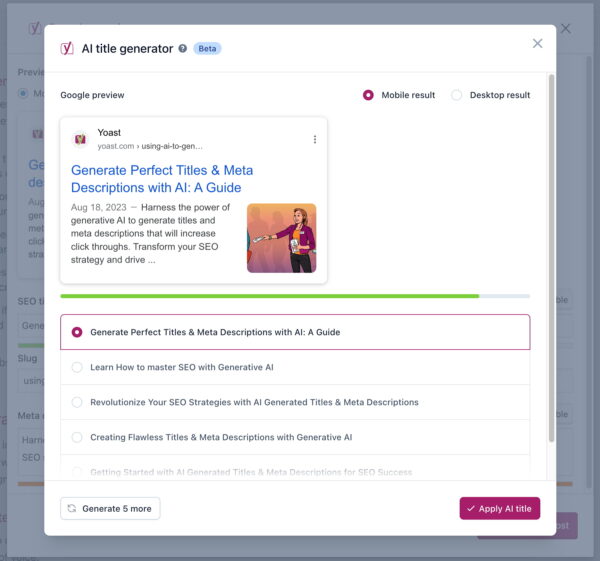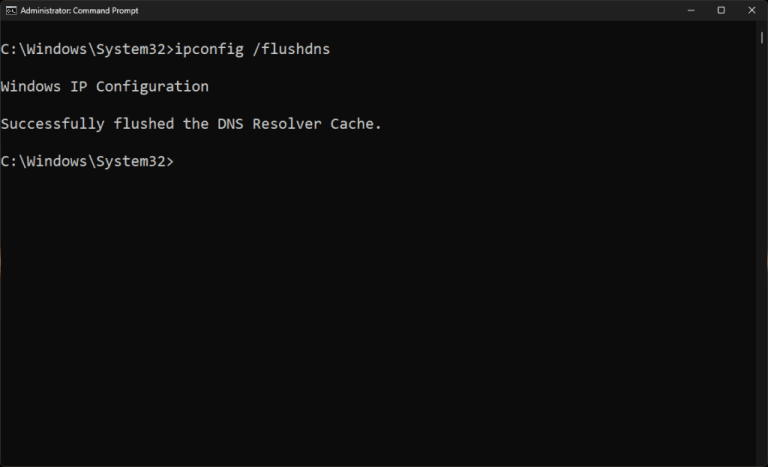AI can streamline this process by automating it. However, you should check the AI-generated suggestions critically. This post will show various methods for generating effective titles and meta descriptions using generative AI for SEO.
Titles and meta descriptions act as your web page’s representatives in the SERPs. These snippets are often the first impression users get of your content, impacting their decision to click and explore further. Therefore, engaging titles and meta descriptions are key to capturing attention, showing relevance, and getting users to visit your site. Generative AI can help write effective ones. When done correctly, integrating generative AI with SEO can be very beneficial.
Improving click-through rates (CTR) and UX
Titles and meta descriptions that sell your content help improve click-through rates. Compelling titles and descriptions are relevant to the users’ search query, which helps them to click on your link.
A higher CTR signals to search engines that your content is valuable, which could lead to more traffic. Moreover, describing the essence of your content helps users find what they’re seeking. This could lead to more engagement, more time spent on your website, and, ultimately, SEO success.
A helpful AI tool in Yoast SEO Premium

Experience the benefits of generative AI and make your work simpler today!
The (un)predictability of Google’s rewriting game
While you invest time and effort in writing titles and meta descriptions, it’s important to note that Google often rewrites them on the SERPs. Therefore, there’s no guarantee that your carefully written titles and meta descriptions will always appear as intended.
Google often thinks it knows how to present your site best. It tends to rewrite stuff to provide users with the most relevant and informative snippets that align with their search intent. Thus, it may rephrase or modify a title or meta description if it believes its version matches the user’s query or accurately represents the content.
Although Google’s rewriting will happen, optimizing your titles and meta descriptions remains useful. Generating good, relevant content increases the likelihood that Google will use your title and meta description.
Use the AI in Yoast SEO Premium to generate titles
Yoast SEO uses AI to generate titles and meta descriptions. Imagine not having to struggle with writing the perfect meta descriptions and titles. Our advanced AI does it for you! It’s designed to understand your content and create engaging titles and descriptions that boost your performance.

Using generative AI to create powerful titles
For SEO, generative AI is a helpful tool for automating the writing of optimized titles. Using state-of-the-art generative AI models like GPT-based models, we can improve our work and generate tailor-made titles for our target audience.
Did you know?

Learn about generative AI and SEO at Yoast SEO Academy
Want to learn how to adapt SEO content strategies for AI? Looking to gain a competitive advantage by integrating AI tools? Check out our training course on AI for SEO!
How to evaluate AI-generated titles
Getting models to spit out titles is not hard, but what comes next is more important. You should check for relevance, keywords, length, uniqueness, and branding when evaluating AI-generated titles. Your titles should be effective and appropriate for your content:
- Clarity and relevance: The title should accurately convey the subject and main focus of the content. It should tell what the page or article is about so that users can see how relevant it is before clicking on it.
- Keyword optimization: Incorporate relevant keywords that fit the content and help search engines understand it. However, keep the title natural and readable, avoiding keyword stuffing or over-optimization.
- Length and readability: The title must be within a certain length to be fully displayed. It must also be easy to read, with proper grammar and punctuation, so users can quickly understand it.
- Engaging and unique: Titles that stand out are more likely to attract clicks. Use AI-generated titles that evoke curiosity, offer a benefit, or create a sense of urgency. Always try to make your titles unique and different from those of your competitors.
- Brand consistency: Check if the AI-generated title aligns with your brand voice and guidelines. Make sure it represents your brand’s personality and values while being consistent across your content.
Remember, there’s still no substitute for human experience. Please take the time to manually improve the work of the generative AI tool of your choice.
Using AI-generated meta descriptions
Titles are not the only things you need to look at, as meta descriptions also play an important role. These summaries get users to click on your link and explore your website. You can optimize your meta descriptions using generative AI to be engaging, informative, and aligned with search intent.
Check the AI-generated meta description
Here are a few aspects to consider when checking AI-generated meta descriptions. In general, look for relevance, length, clickability, and if it has the correct tone of voice.
Ensure that the generated meta description accurately reflects the page’s content for relevance. Verify that the description captures the main topic or purpose of the page and includes relevant keywords or phrases that users might search for.
Looking at length and readability, you should check the length of the generated meta description. Make sure it falls within the desired character limit (around 150-160 characters). Check the readability and clarity of the text so it flows smoothly and is easy to understand for users. See if the message comes across in this short piece of text.
Clickability is important. Consider whether the generated meta description is likely to attract user clicks. Does it address the user’s search intent, highlight the page’s proposition, or create a sense of curiosity or urgency? Aim for attractive descriptions that encourage users to click through to your website.
Another aspect is tone and brand voice. Review the tone and style of the generated meta description to ensure it aligns with your brand voice and messaging guidelines. Does it accurately represent your brand’s personality and values? Make any necessary adjustments to maintain consistency.
Checking generated content using human expertise
Once you have your AI-generated titles and meta descriptions, check these for quality, relevance, and alignment with your objectives. Manual review and refinement from an expert are vital in perfecting the generated content.
Reviewing for quality and coherence
Begin your evaluation by checking the generated titles and meta descriptions for quality and coherence. Assess the language, grammatical correctness, and overall readability. Identify inconsistencies or errors that make the content difficult to understand. By making necessary edits, you improve the quality of the generated content.
Check relevance to content and context
While reviewing the generated output, evaluate its alignment with its content. Consider the specific web page and its context to ensure the generated content accurately portrays the page’s main topic, theme, or purpose and adjust where necessary.
Check brand voice and message
Like any other content, aligning the generated titles and meta descriptions with your brand’s voice, messaging, and tone is critical. Assess how the generated content reflects your brand’s personality and if it resonates with your] audience. Make edits to add your brand’s unique identity to the content while preserving readability.
Optimize keyphrase integration
See if the generated titles and meta descriptions have your target keyword phrases. Keywords play a crucial role in optimizing your content for search engine rankings. Check if the generated content naturally integrates the keywords and their variations.
Analyzing user engagement metrics
In addition to manual review, you should also analyze user engagement metrics to assess the effectiveness of the generated titles and meta descriptions. Monitor impressions, click-through rates, bounce rates, and time spent on the page to understand their impact. Compare the AI-generated content’s performance against alternative variations to determine the best-performing options.
Incorporating human input and expertise
While generative AI can help generate titles and meta descriptions, you shouldn’t underestimate the value of human expertise. Generative AI models are trained on data but lack intuition and an understanding of contextual nuances. By implementing manual review and refinement, you can add your creative insights, industry-specific knowledge, and brand context to the content.
Balancing SEO optimization and user value
Using generative AI for generating titles and meta descriptions is balancing between search engine optimization and delivering value to users. This can help your content perform well in search results while providing your audience with an engaging and meaningful experience.
Understanding user intent
To strike the right balance, understand the intent behind user searches. Analyze the keywords and search queries relevant to your content and consider users’ motivations and expectations when they land on your page.
Providing clear and concise information
When writing, please make sure your titles and meta descriptions tell what users can expect from your page. Clearly outline your content’s main topic, purpose, or value proposition. Use concise language to capture users’ attention and encourage them to click through.
Showcasing unique selling points (USPs)
Titles and meta descriptions are excellent opportunities for your unique selling points. What sets your page or product apart from the competition? Does it offer a unique perspective, in-depth analysis, or insights? By using these selling points in the content, you entice users and demonstrate the value they stand to gain by visiting your page.
Engaging and connecting with users
Titles and meta descriptions help user engagement. Use compelling language, emotional triggers, and storytelling elements that resonate with your audience. Emphasize the benefits, solutions, or outcomes users can achieve by interacting with your content. Stir curiosity or create urgency that helps users to click through and explore further.
Prioritizing readability and usability
Prioritize the readability and usability of your titles and meta descriptions. Use clear and concise language, making information easily understandable. Structure the content in a scannable format, and use proper punctuation and well-defined sections. Make sure the generated output doesn’t compromise readability by focusing solely on optimization.
Generative AI can simplify and optimize the creation of titles and meta descriptions. You can save time, improve click-through rates, and elevate user engagement using AI. Yoast SEO Premium has a helpful AI tool that lets you generate titles and meta descriptions with the click of a button.
However, it’s crucial to remember that AI should improve human expertise, not replace it. Combine the creativity of human writers with generative AI to create titles and meta descriptions that are optimized, captivating, and valuable to users.

![How to Use FTP to Upload Files to WordPress Without Password [Step By Step]](https://stoc.com.au/wp-content/uploads/2025/04/how-to-use-ftp-to-upload-files-to-wordpress-without-password-step-by-step-768x348.png)




